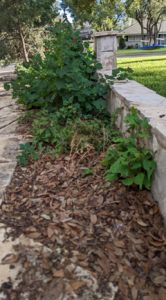By Emmy Ulmschneider
Master Gardeners
A few Monarchs are still drifting by, I am starting to see fall migrant birds, the leaves on my Mexican Buckeye are starting to turn and the okra is definitely hoping for warmer temperatures. Fall is maybe defiantly in the air.
We have previously written about fall tasks to prepare for winter vegetable gardening: tinyurl.com/2fmb8dsv. But what other fall jobs are there?
Gardening ties you to the outside and to the natural flow of the seasons because you notice and follow what your plants are doing, how they are producing and how the weather affects them. In short you are tied to the environment around you. Just as October is the perfect time to sow wildflower seeds, November is the perfect time to prepare for the winter.
First off and foremost, is mulch! Mulch is a layer of non-living materials covering the soil surface around plants, it can be organic (think wood chips or leaves) or inorganic like rock or permeable plastic.

I could wax poetic about the MANY benefits to mulch, but here are my tops five, ok nine:
- inhibits weed seed germination
- reduces evaporation of water from the soil
- moderates soil temperature
- organic mulch breaks down as a slow-release fertilizer
- mineral mulches add minerals as they decompose
- diminishes wind or water erosion
- organic mulches lessen compaction on areas with heavy foot traffic
- gives a more “finished” look and contributes to the “style” of garden
- helps hide irrigation systems from those pesky squirrels
And as everything else in gardening there are good and bad practices. Here are some good mulching practices:
- match the mulch type to your garden
- pull back organic mulches from plant stems or from seeded areas
- maintain organic mulches in a 3-4” layer year-round
- replenish when mulch layer is decomposed by half
- water your mulched area to see if the water is soaking in, you don’t want water running off your yard
I have inorganic mulch only on places I do not grow anything. I use all the organic material I produce as a mulch. The litter from my chicken coop goes out on my eating gardens where it breaks down and releases that all important nitrogen.
Originally, I covered all of my beds with layers of newspaper and bark mulch to inhibit weeds. That has long since broken down and now my mulch of choice is the tree leaves that blow into my yard from my neighbors. This free mulch breaks down over the year, provides a warm winter home for many soil creatures and is critical for the moths and beetles that I want in my yard.
So, leave the leaves, save money, and create a healthier habitat in your yard.
For more information, call the AgriLife office at 498-4071 in Odessa or at 686-4700 in Midland or visit aggie-horticulture.tamu.edu or westtexasgardening.org.




